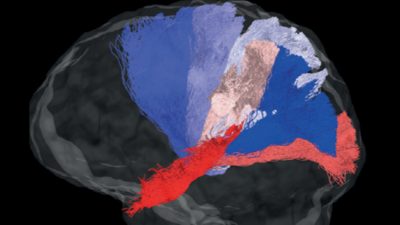- News
- City News
- bengaluru News
- Bengaluru: Machine learning algorithm used to study brain connectivity
Trending
This story is from June 28, 2022
Bengaluru: Machine learning algorithm used to study brain connectivity
Researchers at the Indian Institute of Science (IISc) have developed a new graphic processing unit-based machine learning algorithm that may hold the potential to help better understand and predict connectivity between different regions of the brain.

ReAl-LiFE was also able to predict how a human test subject would behave or do a specific task. IISc claimed such analysis can have medical applications too.
BENGALURU: Researchers at the Indian Institute of Science (IISc) have developed a new graphic processing unit-based machine learning algorithm that may hold the potential to help better understand and predict connectivity between different regions of the brain.
The algorithm — Regularised, Accelerated, Linear Fascicle Evaluation, or ReAl-LiFE — can rapidly analyse enormous amounts of data generated from diffusion Magnetic Resonance Imaging (dMRI) scans of the brain, IISc said, adding that using this, the team evaluated dMRI data over 150 times faster than existing state-of-the-art algorithms can.
“Tasks that previously took hours to days can be completed within seconds to minutes,” said Devarajan Sridharan, associate professor at IISc’s Centre for Neuroscience (CNS) and corresponding author of the study, published in Nature Computational Science.
An IISc statement read: “Millions of neurons fire in the brain every second, generating electrical pulses travelling across neuronal networks from one point to another through connecting cables or ‘axons’, which are essential for computations that the brain performs.”
Saying axons are the brain’s information highways, IISc added because bundles of axons are shaped like tubes, water molecules move through them in a directed manner. Imagine water molecules are cars, Sridharan said, adding: “Information obtained is the direction and speed of vehicles at each point in space and time with no details about roads. Our task is similar to inferring networks of roads by observing traffic patterns.”
To identify these networks accurately, conventional algorithms closely match predicted dMRI signals from inferred connectome with observed dMRI signals. Scientists had previously developed an algorithm called LiFE (Linear Fascicle Evaluation) for this, but one of its challenges was it worked on traditional central processing units (CPUs), which made computation time-consuming.
Now, Sridharan’s team tweaked the algorithm to cut down computational effort involved in several ways, including removing redundant connections, thereby improving upon LiFE’s performance. “To further speed up the algorithm, they also redesigned it to work on specialised electronic chips — the kind found in high-end gaming computers — called GPUs, which helped analyse data at speeds 100-150 times faster,” IISc said.
The algorithm — Regularised, Accelerated, Linear Fascicle Evaluation, or ReAl-LiFE — can rapidly analyse enormous amounts of data generated from diffusion Magnetic Resonance Imaging (dMRI) scans of the brain, IISc said, adding that using this, the team evaluated dMRI data over 150 times faster than existing state-of-the-art algorithms can.
“Tasks that previously took hours to days can be completed within seconds to minutes,” said Devarajan Sridharan, associate professor at IISc’s Centre for Neuroscience (CNS) and corresponding author of the study, published in Nature Computational Science.
An IISc statement read: “Millions of neurons fire in the brain every second, generating electrical pulses travelling across neuronal networks from one point to another through connecting cables or ‘axons’, which are essential for computations that the brain performs.”
While understanding brain connectivity is critical for uncovering brain-behaviour relationships at scale, conventional approaches typically use animal models and are invasive, said Varsha Sreenivasan, PhD student at CNS and first author of the study. She added: “dMRI scans provide a non-invasive method of study.”
Saying axons are the brain’s information highways, IISc added because bundles of axons are shaped like tubes, water molecules move through them in a directed manner. Imagine water molecules are cars, Sridharan said, adding: “Information obtained is the direction and speed of vehicles at each point in space and time with no details about roads. Our task is similar to inferring networks of roads by observing traffic patterns.”
To identify these networks accurately, conventional algorithms closely match predicted dMRI signals from inferred connectome with observed dMRI signals. Scientists had previously developed an algorithm called LiFE (Linear Fascicle Evaluation) for this, but one of its challenges was it worked on traditional central processing units (CPUs), which made computation time-consuming.
Now, Sridharan’s team tweaked the algorithm to cut down computational effort involved in several ways, including removing redundant connections, thereby improving upon LiFE’s performance. “To further speed up the algorithm, they also redesigned it to work on specialised electronic chips — the kind found in high-end gaming computers — called GPUs, which helped analyse data at speeds 100-150 times faster,” IISc said.
End of Article
FOLLOW US ON SOCIAL MEDIA










